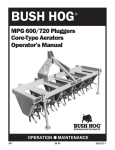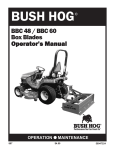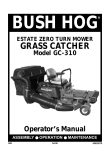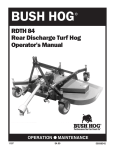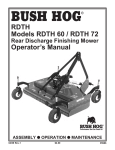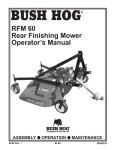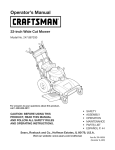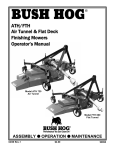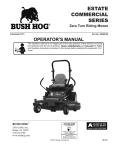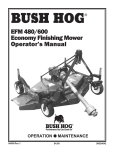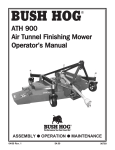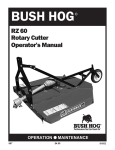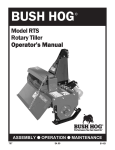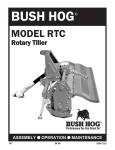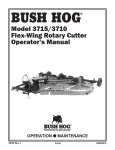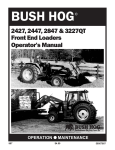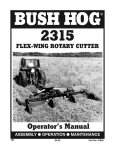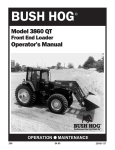Download Bush Hog TD-1100 Operator`s manual
Transcript
BUSH HOG ® MODEL TD - 1100 Tri-Deck Finishing Mower Operator’s Manual ASSEMBLY l OPERATION l MAINTENANCE 04/09 Rev. 1 $4.00 50024754 CONGRATULATIONS! You have invested in the best implement of its type on the market today. The care you give your Bush Hog implement will greatly determine your satisfaction with its performance and its service life. We urge a careful study of this manual to provide you with a thorough understanding of your new implement before operating, as well as suggestions for operation and maintenance. If your manual should become lost or destroyed, Bush Hog will be glad to provide you with a new copy. Order from Bush Hog, 2501 Griffin Ave., Selma, Alabama 36703. Most of our manuals can also be downloaded from our website at www.bushhog.com. As an authorized Bush Hog dealer, we stock genuine Bush Hog parts which are manufactured with the same precision and skill as our original equipment. Our trained service personnel are well informed on methods required to service Bush Hog equipment, and are ready and able to help you. Should you require additional information or assistance, please contact us. YOUR AUTHORIZED BUSH HOG DEALER BECAUSE BUSH HOG MAINTAINS AN ONGOING PROGRAM OF PRODUCT IMPROVEMENT, WE RESERVE THE RIGHT TO MAKE IMPROVEMENTS IN DESIGN OR CHANGES IN SPECIFICATIONS WITHOUT INCURRING ANY OBLIGATION TO INSTALL THEM ON UNITS PREVIOUSLY SOLD. BECAUSE OF THE POSSIBILITY THAT SOME PHOTOGRAPHS IN THIS MANUAL WERE TAKEN OF PROTOTYPE MODELS, PRODUCTION MODELS MAY VARY IN SOME DETAIL. IN ADDITION, SOME PHOTOGRAPHS MAY SHOW SHIELDS REMOVED FOR PURPOSES OF CLARITY. NEVER OPERATE THIS IMPLEMENT WITHOUT ALL SHIELDS IN PLACE. TD1100 Finishing Mower TABLE OF CONTENTS SECTION/PARA PAGE 3-2 Cutting Height Adjustment ...............8 3-3 Operation.........................................9 3-4 Transporting ....................................9 IV.MAINTENANCE ..................................10 4-1 Maintenance Check List ....................10 4-2 Lubrication .........................................10 4-3 Spindle Belt Adjustment ....................11 4-4 Spindle Belt Replacement .............11 4-5 Blade Replacement ......................12 4-6 Troubleshooting.............................12 Safety Decals ................................13 Torque Specifications ....................15 SECTION/PARA PAGE Warranty ................................................2 Dealer Preparation Check List ...............3 Safety Precautions.................................4 Federal Laws and Regulations ..............5 I. INTRODUCTION & DESCRIPTION ......6 1-1 Introduction ......................................6 1-2 Description.......................................6 II. PREPARATION FOR USE ....................7 2-1 Attaching To Tractor .......................7 III.OPERATING INSTRUCTIONS..............8 3-1 General Safety.................................8 RETAIL CUSTOMER’S RESPONSIBILITY UNDER THE BUSH HOG WARRANTY It is the Retail Customer and/or Operator’s responsibility to read the Operator’s Manual, to operate, lubricate, maintain and store the product in accordance with all instructions and safety procedures. Failure of the operator to read the Operator’s Manual is a misuse of this equipment. It is the Retail Customer and/or Operator’s responsibility to inspect the product and to have any part(s) repaired or replaced when continued operation would cause damage or excessive wear to other parts or cause a safety hazard. It is the Retail Customer’s responsibility to deliver the product to the authorized Bush Hog Dealer, from whom he purchased it, for service or replacement of defective parts which are covered by warranty. Repairs to be submitted for warranty consideration must be made within forty-five (45) days of failure. It is the Retail Customer’s responsibility for any cost incurred by the Dealer for traveling to or hauling of the product for the purpose of performing a warranty obligation or inspection. UNDERSTANDING SIGNAL WORDS DANGER: Red Background, White Text - Indicates an imminently hazardous situation which, if not avoided, will result in death or serious injury. This signal word is to be limited to the most extreme situations. WARNING: Orange Background, Black Text -Indicates a potentially hazardous situation which, if not avoided, could result in death or serious injury. 1 CAUTION: Yellow Background, Black Text -Indicates a potentially hazardous situation which, if not avoided, may result in minor or moderate injury. It may also be used to alert against unsafe practices. LIMITED WARRANTY OOOOOOOOOOOOOOOOOOOOOOOOOOOOOOO Bush Hog warrants to the original purchaser of any new Bush Hog equipment, purchased from an authorized Bush Hog dealer, that the equipment be free from defects in material and workmanship for a period of one (1) year for non-commercial, state and municipalities’ use and ninety (90) days for commercial use from date of retail sale. Model TD-1100 gearboxes are covered by a five (5) year limited warranty period. The obligation of Bush Hog to the purchaser under this warranty is limited to the repair or replacement of defective parts. Replacement or repair parts installed in the equipment covered by this limited warranty are warranted for ninety (90) days from the date of purchase of such part or to the expiration of the applicable new equipment warranty period, whichever occurs later. Warranted parts shall be provided at no cost to the user at an authorized Bush Hog dealer during regular working hours. Bush Hog reserves the right to inspect any equipment or parts which are claimed to have been defective in material or workmanship. DISCLAIMER OF IMPLIED WARRANTIES & CONSEQUENTIAL DAMAGES Bush Hog’s obligation under this limited warranty, to the extent allowed by law, is in lieu of all warranties, implied or expressed, INCLUDING IMPLIED WARRANTIES OF MERCHANTABILITY AND FITNESS FOR A PARTICULAR PURPOSE and any liability for incidental and consequential damages with respect to the sale or use of the items warranted. Such incidental and consequential damages shall include but not be limited to: transportation charges other than normal freight charges; cost of installation other than cost approved by Bush Hog; duty; taxes; charges for normal service or adjustment; loss of crops or any other loss of income; rental of substitute equipment, expenses due to loss, damage, detention or delay in the delivery of equipment or parts resulting from acts beyond the control of Bush Hog. THIS LIMITED WARRANTY SHALL NOT APPLY: 1. To vendor items which carry their own warranties, such as engines, tires, and tubes. 2. If the unit has been subjected to misapplication, abuse, misuse, negligence, fire or other accident. 3. If parts not made or supplied by Bush Hog have been used in connection with the unit, if, in the sole judgement of Bush Hog such use affects its performance, stability or reliability. 4. If the unit has been altered or repaired outside of an authorized Bush Hog dealership in a manner which, in the sole judgement of Bush Hog, affects its performance, stability or reliability. 5. To normal maintenance service and normal replacement items such as gearbox lubricant, hydraulic fluid, worn blades, or to normal deterioration of such things as belts and exterior finish due to use or exposure. 6. To expendable or wear items such as teeth, chains, sprockets, belts, springs and any other items that in the company’s sole judgement is a wear item. NO EMPLOYEE OR REPRESENTATIVE OF BUSH HOG IS AUTHORIZED TO CHANGE THIS LIMITED WARRANTY IN ANY WAY OR GRANT ANY OTHER WARRANTY UNLESS SUCH CHANGE IS MADE IN WRITING AND SIGNED BY BUSH HOG’S SERVICE MANAGER, 2501 GRIFFIN AVE., SELMA, ALABAMA 36703. OOOOOOOOOOOOOOOOOOOOOOOOOOOOOOO Record the model number, serial number and date purchased. This information will be helpful to your dealer if parts or service are required. MODEL NUMBER SERIAL NUMBER MAKE CERTAIN THE WARRANTY INFORMATION HAS BEEN FILED ONLINE WITH BUSH HOG SELMA, ALABAMA DATE OF RETAIL SALE 2 DEALER PREPARATION CHECK LIST Tri-Deck Finishing Mower TD-1100 BEFORE DELIVERING MACHINE — The following check list should be completed. Use the Operator’s Manual as a guide. r r r r r r r r r 1. Assembled completed. 2. Gearboxes filled with oil. 3. All fittings lubricated. 4. All shields in place and in good condition. 5. All fasteners torqued to specifications given in Torque Chart 6. All decals in place and readable. (See decal page.) 7. Overall condition good (i.e. paint, welds) 8. Operators manual has been delivered to owner and he has been instructed on the safe and proper use of the cutter. 9. Waranty information has been registered online with Bush Hog. Dealer’s Signature Purchaser’s Signature THIS CHECKLIST TO REMAIN IN OWNER’S MANUAL It is the responsibility of the dealer to complete the procedures listed above before delivery of this implement to the customer. 3 IMPORTANT SAFETY PRECAUTIONS This symbol is used to call attention to safety precautions that should be followed by the operator to avoid accidents. When you see this symbol, carefully read the message that follows and heed its advice. Failure to comply with safety precautions could result in serious bodily injury. In addition to the design and configuration of equipment, hazard control and accident prevention are dependent upon the awareness, concern, prudence and proper training of personnel in the operation, transport, maintenance and storage of equipment. Lack of attention to safety can result in accident, personal injury, reduction of efficiency and worst of all—loss of life. Watch for safety hazards and correct deficiencies promptly. Use the following safety precautions as a general guide to safe operations when using this machine. Additional safety precautions are used throughout this manual for specific operating and mainte nance procedures. Read this manual and review the safety precautions often until you know the limitations. 1. Read the Operator’s Manual. Failure to read the Operator’s Manual is considered a misuse of this equipment. 2. Become familiar with all the machine’s controls and all the caution, warning and danger decals affixed to the machine before attempting to start or operate. 3. Before starting or operating the machine, make a walk around inspection and check for obvious defects such as loose mounting bolts and damaged components. Correct any deficiency before starting. 4. Do not allow children to operate the cutter. Do not allow adults to operate it without proper instruction. 5. Do not carry passengers. 6. Keep the area of operation clear of all persons, particularly small children and pets. The operator should cease mowing whenever anyone comes within the operating area. 7. Clear the work area of objects which might be picked up and thrown. 8. Use a piece of cardboard or wood rather than hands to search for hydraulic leaks. Escaping hydraulic oil under pressure can penetrate skin. If fluid is injected into the skin, it must be surgically removed within a few hours by a doctor familiar with this form of injury or gangrene may result. 9. Do not operate without all guards and shields in place and in good condition. 10. Lower implement to ground, stop tractor engine, apply parking brake, and allow blades to completely stop before leaving the tractor. 11. Keep hands and feet away from blades. 12. This cutter is not to be operated along highways or in any area where people may be present unless all sides of the unit are enclosed by permanent bands, safety chains or other factory approved safety shields that are in good repair. 13. Wear personal protective equipment such as, but not limited to, protection for eyes, ears, feet, hands and head when operating or repairing the equipment. Do not wear loose clothing or jewelry that may catch on equipment moving parts. 14. When performing adjustments or maintenance on the cutter, first lower it to the ground or block it securely at a workable height. 15. Never stand between tractor and cutter while tractor is being backed to the cutter hitch. 16. Reduce speed when transporting cutter to avoid bouncing and momentary loss of steering. 17. Use tractor flashing warning lights, day or night, when transporting cutter on road or highways unless prohibited by law. 18. It is recommended that tractor be equipped with Rollover Protective System (ROPS) and seat belt be used in all mowing operations. 4 IMPORTANT FEDERAL LAWS AND REGULATIONS* CONCERNING EMPLOYERS, EMPLOYEES AND OPERATIONS. *(This section is intended to explain in broad terms the concept and effect of the following federal laws and regulations. It is not intended as a legal interpretation of the laws and should not be considered as such). U.S. Public Law 91-596 (The Williams-Steiger Occupational and Health Act of 1970) OSHA This Act Seeks: “...to assure so far as possible every working man and woman in the nation safe and healthful working conditions and to preserve our human resources...” DUTIES Sec. 5 (a) Each employer— (1) shall furnish to each of his employees employment and a place of employment which are free from recognized hazards that are causing or are likely to cause death or serious physical harm to his employees; (2) shall comply with occupational safety and health standards promulgated under this Act. (b) Each employee shall comply with occupational safety and health standards and all rules, regulations and orders issued pursuant to this Act which are applicable to his own actions and conduct. OSHA Regulations Current OSHA regulations state in part: “At the time of initial assignment and at least annually thereafter, the employer shall instruct every employee in the safe operation and servicing of all equipment with which the employee is, or will be involved.” These will include (but are not limited to) instructions to: Keep all guards in place when the machine is in operation; Permit no riders on equipment; Stop engine, disconnect the power source, and wait for all machine movement to stop before servicing, adjusting, cleaning or unclogging the equipment, except where the machine must be running to be properly serviced or maintained, in which case the employer shall instruct employees as to all steps and procedures which are necessary to safely service or maintain the equipment. Make sure everyone is clear of machinery before starting the engine, engaging power, or operating the machine. EMPLOYEE TRACTOR OPERATING INSTRUCTIONS: 1. Securely fasten your seat belt if the tractor has a ROPS. 5. Watch where you are going, especially at row ends, on roads, and around trees. 2. Where possible, avoid operating the tractor near ditches, embankments, and holes. 6. Do not permit others to ride. 7. Operate the tractor smoothly - no jerky turns, starts, or stops. 3. Reduce speed when turning, crossing slopes, and on rough, slick, or muddy surfaces. 8. Hitch only to the drawbar and hitch points recommended by tractor manufacturers. 4. Stay off slopes too steep for safe operation. 9. When tractor is stopped, set brakes securely and use park lock if available. Child Labor Under 16 Years Old Some regulations specify that no one under the age of 16 may operate power machinery. It is your responsibility to know what these regulations are in your own area or situation. (Refer to U.S. Dept. of Labor, Employment Standard Administration, Wage & Home Division, Child Labor Bulletin #102.) 5 SECTION I INTRODUCTION AND DESCRIPTION 1-1 INTRODUCTION 1-2 DESCRIPTION We are pleased to have you as a Bush Hog customer. Your TD-1100 Finishing Mower has been carefully designed to give maximum service with minimum down time. This manual is provided to give you the necessary operating and maintenance instructions for keeping your mower in top operating condition. Please read this manual thoroughly. Understand what each control is for and how to use it. Observe all safety precautions decaled on the machine and noted throughout the manual for safe operation of implement. If any assistance or additional information is needed, contact your authorized Bush Hog distributor. The TD-1100, Figure 1-1, is designed for turf maintenance applications where a high quality of cut on turf grasses is required. The caster wheel arrangement along with the flexible, floating deck attachment and the standard front mounted rollers, all work together to give an even cut and minimize scalping. NOTE: The inside rear wheel on the wing mower decks and both the front wheels on the rear mower deck are rigidly mounted and are not designed to caster. Power from the tractor is transmitted through a telescoping driveline to a belt drive and gearbox arrangement which allows either wing unit to be folded up to 30° while still operating. Power is passed to the spindle housings by a B-section, Kevlar reinforced belt. Drivetrain protection is provided by belt slippage. NOTE All references made to right, left, front, rear, top or bottom are as viewed facing the direction of travel with implement properly attached to tractor. Technical Specifications Specification TD-1100 Cutting Width . . . . . . . . . . . . . . . . . . . . . . . 11’ Transport Width . . . . . . . . . . . . . . . . . . . . . 78” Cutting Height . . . . . . . . . . . . . . . . . . . 3/4 to 4-1/2” Blade Tip Speed (FPM) . . . . . . . . . . . 16,100 FPM Required Tractor Horsepower . . . . . . . 30 HP min. Wing Flex . . . . . . . . . . . . . . . . . . . . 30° up, 10° down Belts. . . . . . . . . . . . . . . . . . . . . . . . . . . . . Kevlar Driveline Size . . . . . . . . . . . . . . . Cat. IV 80° CV (main), Cat. III (wing) Figure 1-1 TD-1100 6 SECTION II PREPARATION FOR USE NOTE: TD-1100 units using standard single acting hydraulic cylinders require tractors which are equipped with a “float” position in their hydraulic systems to allow the wing decks to follow the contour of the ground. If your particular model tractor does not have a “float” position in its hydraulic system, a double acting hydraulic cylinder conversion kit should be installed. See your Bush Hog dealer. Before operation, service all locations outlined in Section 4-2 “Lubrication” and remove transport lock pins from mower decks as shown in Figure 3-4. Unpin inside wing tires and reposition into a trailing position and repin in place. Run-in the mower in a static condition at half throttle for 30 minutes. Inspect all belts for proper tension; check gearboxes for proper oil level; and check to make sure blade spindles are not overheating. B. Attach jackstand to frame of cutter. Extend jackstand to support weight of frame. C. Connect clevis hitch to tractor drawbar using a 1 inch (25mm) diameter approved pin with lynch pin retainer or equivalent. D. Adjust tongue and clevis angle as necessary to keep mower frame level with ground when attached to drawbar. (Figure 2-2) 2-1 ATTACHING TO TRACTOR IMPORTANT (540 RPM only) The minimum required PTO horsepower is 30 HP for the TD-1100. WARNING NEVER STAND BETWEEN TRACTOR AND MOWER WHILE TRACTOR IS BEING BACKED TO HITCH. Figure 2-2 Tongue/Clevis Adjustment Tongue Adjustment A. Adjust tractor drawbar length to dimension shown in Figure 2-1. Incorrect drawbar length will change angle of driveline causing possible damage to constant velocity joint. See tractor operator’s manual for drawbar adjustment procedure. Clevis (Note Bolt Locations Pointed Out By Arrows) Drawbar Height 8” - 12-1/2” 12-1/2” - 17” Figure 2-1 Tractor Drawbar Adjustment Above 17” NOTE: Offset drawbar must be turned down as shown. It is important that the TD be operated in a level position. Leveling can be accomplished by adjusting the implement hitch to the tractor draw bar height and leveling the mowerframe by use of the adjustable jackstand. If after turning the offset draw bar downward, there is less than 7” ground clearance, it should be replaced with a straight draw bar or the unit cannot be properly leveled. If after properly leveling the mower deck the draw bar height is less than 8”, a standard pull pin may be too long. To prevent turf damage in uneven terrain, the standard pin should be replaced with a 1 x 5” Grade 5 bolt with locknut securely tightened. E. Connect hydraulic hose to tractor remote quick couplers.(See tractor dealer if furnished couplers are not correct for your particular tractor) Make sure hydraulic line is not twisted or kinked. WARNING USE A PIECE OF CARDBOARD OR WOOD RATHER THAN HANDS AND WEAR EYE PROTECTION WHEN SEARCHING FOR HYDRAULIC LEAKS. ESCAPING HYDRAULIC OIL UNDER PRESSURE CAN PENETRATE SKIN. IF OIL IS INJECTED INTO SKIN, IT MUST BE SURGICALLY REMOVED WITHIN A FEW HOURS OR GANGRENE MAY RESULT. 7 F. Route control chain to convenient location and fasten to tractor. Be sure excess slack is removed from the chain to avoid entanglement with tractor tires or other moving parts. Make sure latch locking pins are in the stored positions so that latches can Figure 2-3 be released by pulling the chain.(Refer to Figures 3-3 and 3-4) G. Attach driveline to tractor . Pull on each driveline section to be sure that yoke locks into place. H. Securely attach safety tow chain to tractor. Control Chain SECTION III OPERATING INSTRUCTIONS pings on the surface. The more frequently the grass is mowed, the better the effect will be. 3-1 GENERAL SAFETY Only qualified people familiar with this operator’s manual and tractor operator’s manual should operate this machine. Operator should wear hard hat, safety glasses and safety shoes. The operator should read, understand and practice all safety messages shown on the caution, warning and danger decals affixed to the mower to avoid serious injury or death. It is recommended that tractor be equipped with Rollover Protective System (ROPS) and a seat belt be used. Before beginning operation, clear work area of any objects that may be picked up and thrown. Check for ditches, stumps, holes or other obstacles that could upset tractor or damage mower. Always lower mower to ground and allow blades to come to a complete stop, set parking brake and turn off tractor engine before leaving tractor operator’s seat. A. Raise mower off ground enough to remove caster. WARNING THE MOWER CAN FALL FROM HYDRAULIC SYSTEM FAILURE. TO AVOID SERIOUS INJURY OR DEATH, SECURELY SUPPORT MOWER BEFORE WORKING UNDERNEATH. B. Remove pin securing caster stem to caster arm. Remove caster stem from caster arm. C. Place amount of spacers on caster stem to give desired cutting height. With no spacers on the bottom, a 3/4” cutting height is given. (Figure 3-1) D. Reinstall caster stem into caster arm. Place remaining spacers on caster stem above caster arm and install pin to retain. E. Repeat operation for all caster wheels. Make certain all wheels are adjusted to the same height. NOTE: Before initial operation the TD should be connected to the tractor for a 30 minute “run in” cycle. During the “run in” phase, the tractor should be operated at only half throttle. The “run in” phase will allow belt warmup and stretching for proper mowing performance. After the 30 minute “run in” cycle is complete, ALL belts should be inspected for proper tension and if adjustments are necessary, refer to Maintenance Section. Figure 3-1 Caster Wheel Spacers 3-2 CUTTING HEIGHT ADJUSTMENT The mower should be operated at the highest position that will give desired cutting results. This will help prevent blades from striking the ground, reducing blade wear and undue strain on the machine. Cutting too much material may leave excess clip8 When mowing across slopes, yawing or skewing may occur as the mower slips sideways which may cause streaking. In this case, mowing up and down slopes should be done to eliminate skewing. 3-3 OPERATION A. Perform BEFORE EACH USE maintenance list in paragraph 4-1. B. Standard Models With Single Acting Cylinders Start tractor. Lower cutter decks until it is supported by caster wheels and place hydraulic valve in “float” position. Models Equipped With Double Acting Hydraulic Cylinder Conversion Kit - Start tractor. Lower cutter decks until it is supported by caster wheels and hydraulic cylinders are fully extended to allow mechanical float to operate. (Figure 3-2) 3-4 TRANSPORTING IMPORTANT- Before folding for transport, disengage the PTO and wait for blades to stop. Pull the latch chain to allow complete folding, then release the chain to lock decks in the raised position. These locks also serve the purpose of limiting the upward flex of the cutter decks during operation. Figure 3-2 Make Sure Cylinders Are Fully Extended To Allow Decks To Float Install pins into the transport lock positions. (Figures 3-3, 3-4, & 3-5) When implement is transported on road or highway, day or night, use tractor flashing warning lights unless prohibited by law. The slow moving vehicle (SMV) sign must be visible from the rear by approaching vehicles. Wing CylinderLug Spacing LUG SPACING Figure 3-3 Center Unit Transport Latch Rear Cylinder Lug Space DANGER STAY CLEAR OF ROTATING DRIVELINE. DO NOT OPERATE WITHOUT DRIVELINE SHIELDS IN PLACE AND IN GOOD CONDITION. FAILURE TO HEED THESE WARNINGS MAY RESULT IN PERSONAL INJURY OR DEATH. Pin In “Working” Position Transport Lock Hole NOTE: The mower deck transport locking pins provided on the wing sections (Figure 3-4) MUST be removed BEFORE operation. Failure to remove these locking pins will result in front caster wheel damage, turf damage, and unacceptable mowing performance DANGER STAND CLEAR OF ROTATING CUTTER BLADES UNTIL ALL MOTION HAS STOPPED. TO AVOID ACCIDENTAL FALL AND POSSIBLE INJURY FROM CUTTER, IT IS RECOMMENDED THAT TRACTOR BE EQUIPPED WITH ROLLOVER PROTECTIVE SYSTEM AND THAT A SEAT BELT BE USED FOR ALL OPERATIONS Figure 3-4 Wing Unit Transport Latch C. With tractor at idle speed, engage PTO drive. Advance throttle to 540 PTO rpm. D. Place tractor in low gear and begin cutting. Tractor forward speed should be controlled by gear selection, not engine speed. For maximum cutting efficiency, forward speed should allow mower to maintain a constant maximum blade speed. If tractor engine or cutter stalls, do not slip tractor clutch to allow engine to retain speed as this will exert undue strain on the implement drivetrain. When stalling occurs, disengage PTO drive, move to a cut area, set tractor throttle to idle, then re-engage PTO drive. Pins In Transport Positions Holes For Storing Pins During Work 9 SECTION IV MAINTENANCE 4-1 MAINTENANCE CHECK LIST Perform scheduled maintenance as outlined below. Lower implement to ground, turn off tractor, and set parking brake before doing maintenance inspections or work. All bolts should be torqued as indicated in torque chart unless otherwise indicated. 4-2 LUBRICATION (Figures 4-1A, B & C) NOTE The multi-purpose grease referenced in this section is an NLGI Grade 2 type grease. Figure 4-2 shows the necessary position for servicing wing drivelines. BEFORE EACH USE 1. Driveline Universal Joints - Apply multi-purpose grease with grease gun. 2. Driveline Guard - Apply 2-3 shots of multi-purpose grease with grease gun to plastic fitting. 3. Wheels - Apply multi-purpose grease with grease gun. 4. Caster Pivot - Apply multi-purpose grease with grease gun. 5. Constant Velocity (CV) Joint - Position CV joint as straight as possible to be sure grease will penetrate to ball joint. Lubricate the central body with a minimum of 30 shots of grease every 8 hours. Lubricate telescoping members with 10 shots every 8 hours and every 40 hours pull the two sections apart, apply thin coat of multi-purpose grease to outside of inner (male) section and reassemble. 6. Gearboxes (5) - Add EP80W-90 gear oil, if necessary, to bring oil level to check plug or dip stick mark. WARNING THE MOWER CAN FALL FROM HYDRAULIC SYSTEM FAILURE. TO AVOID SERIOUS INJURY OR DEATH, SECURELY SUPPORT MOWER BEFORE WORKING UNDERNEATH. BEFORE EACH USE. 1. Check tractor tire air pressure. Refer to tractor operator’s manual. Mower transport tire pressure should be 22 psi; deck tire pressure should also be 22 psi. 2. Check blades and spindles to be sure that no foreign objects such as wire or steel strapping bands are wrapped around them. 3. Check blade bolts for tightness. Tighten blade bolts to 76 ft./lbs. 4. Inspect blades for wear. Replace if necessary per paragraph 4-5. Use only genuine Bush Hog replacement parts. If it is necessary to sharpen the blades, remove the blades from the spindles before sharpening. DO NOT sharpen blades while still attached to mower. 5. Make certain all shields are in place and in good condition. Repair or replace any missing or damaged shields. 6. Inspect wheel(s) for wear, damage or foreign objects. Repair or replace if necessary. 7. Perform BEFORE EACH USE lubrication per paragraph 4-2. 8. During operation, listen for abnormal sounds which might indicate loose parts, damaged bearings, or other damage. Correct any deficiency before continuing operation. 20 HOURS 7. Deck Drivelines - Disconnect PTO driveline, pull the two sections apart, apply thin coat of multipurpose grease to outside of inner (male) section. Reassemble sections and install. Pull each section to be sure driveline and shields are securely connected. Make certain PTO shielding is in good condition. 40 HOURS 8. Wing Pivots - Apply 5 shots of multi-purpose grease with grease gun. 9. Cylinder Rod Lugs - Apply 5 shots of multi-purpose grease with grease gun. 10. Deck Pivots - Apply 5 shots of multi-purpose grease with grease gun. 11. Spindle Assembly - Apply 3-5 shots of multipurpose grease with grease gun. AFTER EACH USE 1. Clean all debris from machine especially underside of deck, underneath belt shield and off safety decals. Replace any missing or illegible decals. 2. Inspect cutter for worn or damaged components. Repair or replace before next use. Any replacement components installed during repair shall include the components’ current safety decals specified by the manufacturer to be affixed to the component. 3. Store cutter in a dry place. END OF SEASON 12. Transport Wheel Bearings - Pack transport wheel bearings with grease at end of each mowing season. 40 HOURS 1. Check belt for proper tension. Refer to paragraph 4-3. 10 Figure 4-1 B (5) 30 Shots Before Each Use (1) 3 Shots Before Each Use (5) 10 Shots Before Each Use (Access through holes in shields of telescoping driveline) Figure 4-1A (2) Before Each Use (1) Before Each Use Figure 4-1 C To Remove Shield: Turn slotted head 90° with screwdriver, remove turn screw and slide cover back. (9) 40 Hrs 6) Before Each Use (11) 40 Hrs (3) Before Each Use (10) 40 Hrs (8) 40 Hrs (12) End Of Season (4) Before Each Use (10) 40 Hrs sheave. 3. Work the belt over the other sheaves. 4. Connect the adjustment rod and the idler assembly. 5. Tighten the compression springs on the drive to 2-7/8” long. Tighten the jam nut on the adjustment rod. 6. Replace all shields before operating machine. 4-3 SPINDLE BELT ADJUSTMENT Belt tensions should be checked every 40 hours to get maximum life from drive belts and best performance from the cutter. Belt tension is adjusted by increasing or decreasing the length of the spring on the moveable idlers. For proper belt tension on the mower, the spring lengths should be set at 27/8”. (Figure 4-2) To adjust the spring length, loosen or tighten the 1/2” hex nuts on the spring adjustment rod until the correct spring length is reached. Figure 4-2 Spindle Belt Diagram Adjustment Rod & Spring 4-4 SPINDLE BELT REPLACEMENT Idler Assembly Use only genuine Bush Hog replacement parts. A. Flip up black latches and remove right and left side shields. To remove the outside shields on the wing cutter decks, the wings must be in the folded position. B. Relieve spring tension by loosening the two 1/2” hex nuts on each spring adjustment rod. (Figure 4-2) C. Remove old belt. D. Install new belt as shown below. (Also refer to the decal on underside of belt shield) 2-7/8” 1. Disconnect the adjustment rod from the idler assembly. (Figure 4-2) 2. Place belt into the groove on the driving 11 Driving Sheave At Gearbox C. Remove bolt and Belleville washer securing bottom blade to spindle. Remove blade. Shaft washer will come off with the blade. D. Install the blade washer over the spindle shaft. Install the blade and torque the 1/2” - 20UNF Gr. 8 bolt to 76 ft./lbs. Note: The concave side of the belleville washer must be toward the blades. Do not substitute with a flat washer. 4-5 BLADE REPLACEMENT CAUTION WEAR HEAVY WORK GLOVES TO PROTECT HANDS FROM SHARP EDGES. WHEN TURNING BLADES, BE AWARE OF OPPOSITE BLADE APPROACHING. A . Raise cutter using tractor hydraulic system and use transport locks before changing blades. B. Turn off tractor,set parking brake and remove key. 4-6 TROUBLESHOOTING Troubleshooting procedures are listed in Table 4-1 below. If the problem cannot be solved or replacement parts are necessary, contact your authorized Bush Hog dealer. Please have ready your machine name, model number, serial number, purchase date and exact cause or description of problem. Table 4-1 Troubleshooting PROBLEM PROBABLE CAUSE REMEDY Cutter not level side to side or front to rear. See SECTION III. Belt slipping. Adjust belt per paragraph 4-3. Worn or bent blade(s). Replace blade(s). Possible build-up of material under cutter. Clean cutter. Cutter not level. See SECTION III. Worn blades. Replace blades. Belt slipping. Adjust belt per paragraph 4-3. Mowing across slopes Mow up and down slopes Loose components. Check all bolts for tightness. Low oil in gearbox. Check oil per paragraph 4-2. Rapid Blade Wear (cutting edge) Blade contacting ground. Adjust cutting height to eliminate ground contact. Rapid Blade Wear Cutter not being operated at rated PTO speed. Set tractor throttle for proper PTO speed. Uneven Cut Streaking or Windrowing Noisy Cutter Use lower gear. Cutter Vibrating Cutter not being operated at rated PTO speed. Set tractor throttle for proper PTO speed. Blade(s) bent. Replace blades. Foreign object wrapped around spindle or blade. Remove object. 12 SAFETY DECALS To promote safe operation, Bush Hog supplies safety decals on all products manufactured. Because damage can occur to safety decals either through shipment, use or reconditioning, Bush Hog will, upon request, provide safety decals for any of our products in the field at no charge. Contact your authorized Bush Hog dealer for more information. DANGER KEEP AWAY! 50012615 SHIELD MISSING FROM THIS AREA TO AVOID SERIOUS INJURY OR DEATH, DO NOT OPERATE WITHOUT THIS AND ALL OTHER SHIELDS IN PLACE AND IN GOOD CONDITION. 50012616 50012616 50042289 IMPLEMENT CAN FALL FROM HYDRAULIC SYSTEM RELEASE. TO AVOID SERIOUS IMPLEMENT CAN FALL FROM HYDRAULIC INJURY OR DEATH: SYSTEM RELEASE. TO AVOID SERIOUS SHUT OFF TRACTOR ENGINE, REMOVE KEY, SECURE INJURY OR DEATH: • TR ACTOR PARKING BRAKE AND BLOCK UP OR SECURELY SHUT OFF TRACTOR ENGINE, REMOVE KEY, SECURE SU PPORT IMPLEMENT BEFORE WORKING UNDERNEATH. TRACTOR PARKING BRAKE AND BLOCK UP OR SECURELY SUPPORT IMPLEMENT BEFORE WORKING UNDERNEATH. STAND CLEAR IF LOWERING OR RAISING IMPLEMENT. • • IMPLEMENT. • STAND CLEAR IF LOWERING OR RAISING50042284 50042284 50042284 50042282 50042281 50042283 13 DECALS CONTINUED 50042285 83343 50042286 50042286 78608 78786 14 TORQUE SPECIFICATIONS Proper toque for American fasteners used on Bush Hog equipment. Recommended Torque in Foot Pounds (Newton Meters).* AMERICAN Bolt Head Markings SAE Grade 2 (No Dashes) SAE Grade 5 (3 Dashes) ” lt Bo ter “B e m Dia Wrench Size “A” SAE Grade 8 (6 Dashes) METRIC WRENCH SIZE (IN.) “A” BOLT DIAMETER (IN.) “B” AND THREAD SIZE SAE GRADE 2 SAE GRADE 5 SAE GRADE 8 7/16 1/4 - 2O UNC 6 (7) 8 (11) 12 (16) 7/16 1/4 - 28 UNF 6 (8) 10 (13) 14 (18) 1/2 5/16 - 18 UNC 11 (15) 17 (23) 25 (33) 1/2 5/16 - 24 UNF 13 (17) 19 (26) 27 (37) 9/16 3/8 - 16 UNC 20 (27) 31 (42) 44 (60) 9/16 3/8 - 24 UNF 23 (31) 35 (47) 49 (66) 5/8 7/16 - 14 UNC 32 (43) 49 (66) 70 (95) 5/8 7/16 - 20 UNF 36 (49) 55 (75) 78 (106) 3/4 1/2 - 13 UNC 49 (66) 76 (103) 106 (144) 3/4 1/2 - 20 UNF 55 (75) 85 (115) 120 (163) 7/8 9/16 - 12 UNC 70 (95) 109 (148) 153 (207) 7/8 9/16 - 18 UNF 79 (107) 122 (165) 172 (233) 15/16 5/8 - 11 UNC 97 (131) 150 (203) 212 (287) 15/16 5/8 - 18 UNF 110 (149) 170 (230) 240 (325) 1-1/8 3/4 - 10 UNC 144 (195) 266 (360) 376 (509) 1-1/8 3/4 - 16 UNF 192 (260) 297 (402) 420 (569) 1-5/16 7/8 - 9 UNC 166 (225) 430 (583) 606 (821) 1-5/16 7/8 - 14 UNF 184 (249) 474 (642) 668 (905) 1-1/2 1 - 8 UNC 250 (339) 644 (873) 909 (1232) 1-1/2 1 - 12 UNF 274 (371) 705 (955) 995 (1348) 1-1/2 1 - 14 UNF 280 (379) 721 (977) 1019 (1381) 1-11/16 1-1/8 - 7 UNC 354 (480) 795 (1077) 1288(1745) 1-11/16 1-1/8 - 12 UNF 397 (538) 890 (1206) 1444 (1957) 1-7/8 1-1/4 - 7 UNC 500 (678) 1120 (1518) 1817 (2462) 1-7/8 1-1/4 - 12 UNF 553 (749) 1241 (1682) 2013 (2728) 2-1/16 1-3/8 - 6 UNC 655 (887) 1470 (1992) 2382 (3228) 2-1/16 1-3/8 - 12 UNF 746 (1011) 1672 (2266) 2712 (3675) 2-1/4 1-1/2 - 6 UNC 870 (1179) 1950 (2642) 3161 (4283) 2-1/4 1-1/2 - 12 UNF 979 (1327) 2194 (2973) 3557 (4820) ” lt Bo ter “B e iam D Wrench Size “A” 8.8 Numbers appearing on bolt heads indicate ASTM class. *Use 75% of the specified torque value for plated fasteners. Use 85% of the specified torque values for lubricated fasteners. Proper torque for metric fasteners used on Bush Hog equipment. Recommended torque in foot pounds (newton Meters).* WRENCH SIZE (mm) “A” BOLT DIA. (mm) “B” ASTM 4.6 8 5 1.8 (2.4) 5.1 (6.9) 6.5 (8.8) 10 6 3 (4) 8.7 (12) 11.1 (15) ASTM 8.8 ASTM 9.8 ASTM 10.9 13 8 7.3 (10) 21.1 (29) 27 (37) 16 10 14.5 (20) 42 (57) 53 (72) 18 12 25 (34) 74 (100) 73 (99) 93 (126) 21 14 40 (54) 118 (160) 116 (157) 148 (201) 181 (245) 24 16 62 (84) 167 (226) 30 20 122 (165) 325 (440) 33 22 443 (600) 611 (828) 36 24 211 (286) 563 (763) 778 (1054) 41 27 821 (1112) 1138 (1542) 46 30 418 (566) 1119 (1516) 1547 (2096) 15 230 (312) 449 (608) 2501 Griffin Ave.l Selma, AL 36703 Telephone (334) 874-2700 l www.bushhog.com



















